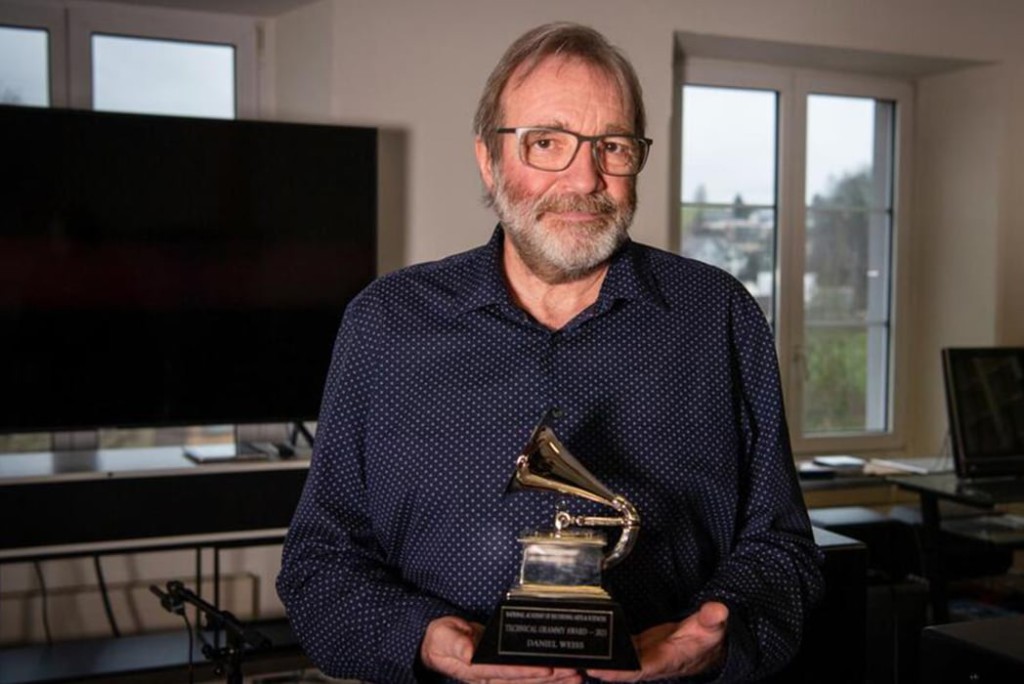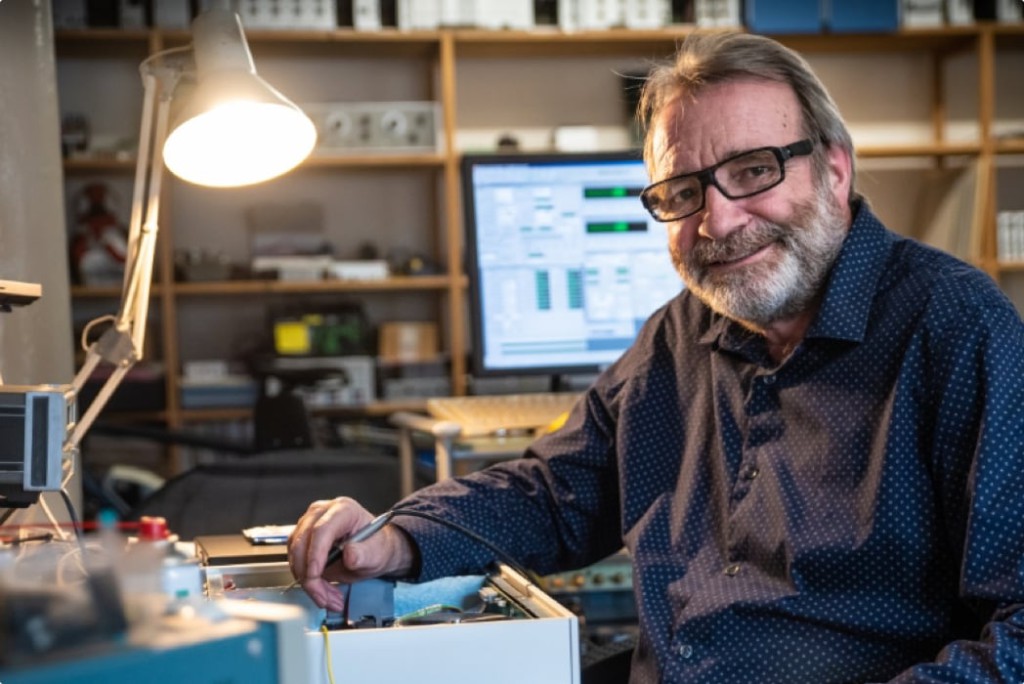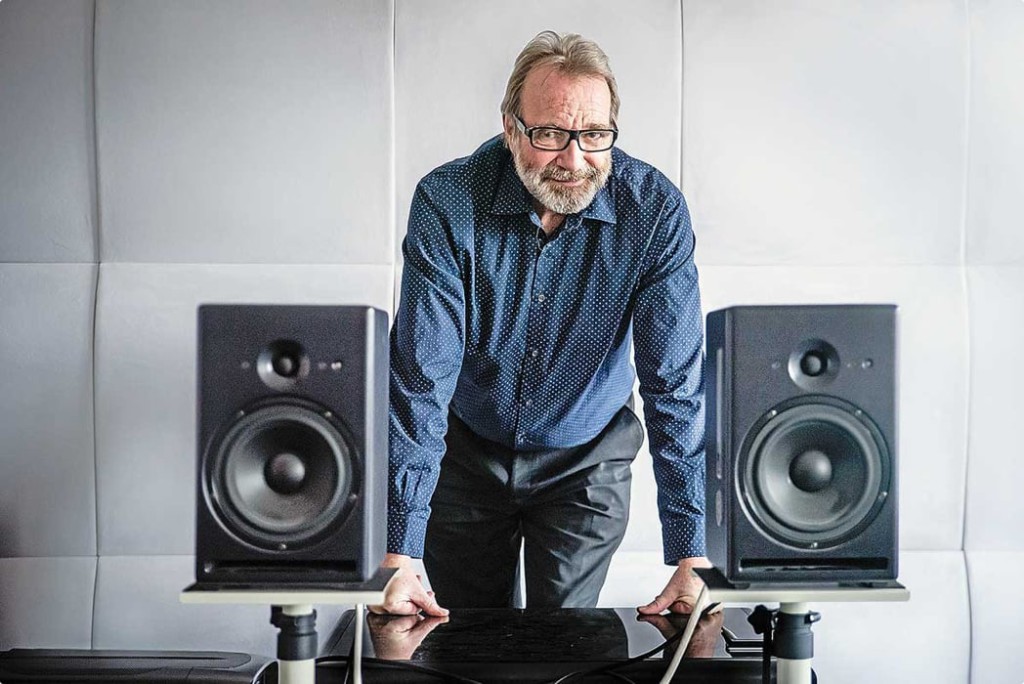Art and Science With Daniel Weiss
From DIY analog synthesizers to celebrated mastering and audiophile equipment, Daniel Weiss has spent most of his life in the intersection of music and technology. Please meet the founder and principal of Weiss Engineering.
Daniel Weiss is widely regarded as one of the pioneers of audio technology, further underlined by his recently awarded Technical Grammy for his many achievements. But where audio innovators such as Georg Neumann, Bill Putnam, and Rupert Neve made advances in analog technology, Daniel’s contribution mainly lies in the digital realm. He was among the first to create digital tools for audio processing, with plenty of industry-first innovations since the late 1970s.
Daniel is a 66-year-old Swiss whose company is based just outside the city of Zürich. Weiss Engineering has eight employees, and all the company’s products are developed, designed, and manufactured in Switzerland. Like many other successful people, Daniel started early.
Weiss Engineering has trailblazed digital audio for almost four decades. Here is Daniel Weiss himself, sharing the full story behind the brand and the products. Please note: The video and the text contain separate interviews.
I try to create units that aren’t just me-too products. I want to fill a gap by bringing something extra to the market.
Daniel Weiss
“I was interested in electronics already as a kid. I built radio receivers and all that stuff. I was also interested in music, and I played the violin from an early age, followed by the bass guitar. So getting involved with audio electronics was a logical step. I also built many synthesizers in the early to mid-1970s, basing the first ones on schematics published in Wireless World magazine. I later borrowed some features from commercially available synths to improve my own models, and I still have some of those in my possession.
Daniel reveals he’s still somewhat active as a musician and owns a Buchla Marimba Lumina. He is also a regular concert-goer with varied musical tastes, and mentions the Swiss industrial music pioneers The Young Gods as one of his favorite acts.
The beginning of weiss engineering
In addition to synths, Daniel built some speakers and amplifiers in the 1970s and had a small business called White Amplifiers. Weiss means “white” in German, hence the name of his company. In Daniel’s own words:
“I studied electrical engineering and joined the iconic Swiss audio manufacturer Studer in 1979 when they started looking into digital audio. These were the very early days of digital audio. The first product I developed for them was a sampling frequency converter. There weren’t any uniform standards for sampling frequency or interfacing at the time, so we built a unit that could convert between more or less any sampling rates.”
A few years on, Studer was approached by German mastering engineer Ben Bernfeld, who needed an interface between two Sony digital audio tape machines and contacted Studer to see if they’d be able to provide that. Studer wasn’t able to take on custom work, but Daniel was. So in his spare time, he started developing Ben’s device, and more units were to follow.

When people feel Weiss products have a soul, it’s not because the devices are somehow sweetening the sound. It’s because people are hearing a purer representation of the audio than ever before.
Daniel Weiss
“It turned out that there was a niche market for digital signal processing for mastering, which grew further when the CD format became available around 1982. I quickly realized that mastering engineers had to go back and forth between analog and digital, and at the time, the converters were a weak link in the chain. By providing units that would allow the mastering engineer to process audio in the digital domain, it was only necessary to make one conversion—from the analog master tape to the digital tape machine. So Ben Bernfeld and I worked together. He knew which tools were required for mastering, and I did the development and production. We started Weiss Engineering, and I left my job at Studer soon afterward.”
Daniel’s units became the 102 series, a modular system distributed worldwide by Ben Bernfeld’s business, Harmonia Mundi Acustica. The units were successful and led to the development of a full digital mastering console called the IBIS. Sony Music in New York was among the first IBIS owners. According to Daniel, there are still a few 102 systems in use—quite impressive for almost 40 years old digital audio devices! However, it became clear that the 19-inch rack format was preferred by most engineers, which sparked the creation of the Gambit series in the early 1990s. The Gambit series includes the renowned EQ1 and DS1, an equalizer and a compressor/limiter/de-esser, which are staples in mastering studios worldwide to this day.
The next chapter for Weiss Engineering started in 2000. That’s when the brand expanded its scope to include music listeners in addition to music creators. A product line for the high-end hi-fi market was launched, beginning with the ultra-precision digital-to-audio converter MEDEA and the CD transport Jason. Entering the audiophile market turned out to be a successful step, and Weiss units are now used in high-end home cinemas and listening rooms worldwide.
HOW TO CREATE AUDIO EQUIPMENT
The inspiration for Daniel’s products often comes from discussions with trusted friends and partners and input from end customers and distributors. Daniel says:
“I try to create units that aren’t just me-too products. I want to fill a gap by bringing something extra to the market. For example, I’ve incorporated digital signal processing in our high-end hi-fi units with algorithms taken from our professional audio units. With our DAC501/502 and the DSP501/502 units, I encourage the users not to be afraid of adapting the sound to their taste. If the bass in a recording is a bit too weak, they can correct it, using the same algorithms that are in the mastering units.”
This may be controversial to some audiophiles who believe that high-end hi-fi equipment should do one thing only, which is to reproduce the audio as closely as possible to the original recording. Nothing added, nothing taken away. But Daniel doesn’t seem to mind going beyond that.
“There’s this idea in the audiophile world that the end-user isn’t allowed to change anything—they should just play back whatever is on the recording. I disagree with that idea. Unfortunately, not all recordings are great, so why not give users the ability to improve them upon playback? And the playback situation is all over the place anyways. People’s speakers and rooms create vastly different results, so I think it’s entirely OK for the listeners to change the sonics if they want to. That’s why I’ve included such features in some of our units.”
Reading reviewer’s and user’s statements on various Weiss units, one thing that is often repeated is how musical they sound—often being described as “digital devices with a soul.” The mastering guru Bob Katz has jokingly said about the EQ1 that it’s the most analog-sounding equalizer he has ever heard. So do the Weiss products impart character to the audio?
“No. A lot of effort goes into making all Weiss products as clean and true to the original as possible. It’s OK for a music listener to alter the sound to their taste deliberately, but if you choose not to, the devices should reproduce the audio perfectly, with the flattest frequency response and the lowest distortion possible. So when people feel Weiss products have a soul, it’s not because the devices are somehow sweetening the sound. It’s because people are hearing a purer representation of the audio than ever before.”

We don’t want to limit our users in any way.
Daniel Weiss
ART AND SCIENCE
This leads us to the alleged dichotomy between science and art. Weiss Engineering designs creative tools for making art and telling stories. In addition, the company makes devices that allow an audience to experience that same art and immerse themselves in the creators’ stories. But the core of Weiss Engineering’s success is, of course, that Daniel understands the science behind all these devices better than most. So what component of art and science is the most important to him?
“I approach my development work from a scientific point of view. The technical side of things needs to be OK. It’s the sound engineer who has the artistic job and who decides how the audio should sound in the end. My job is to provide the tools for that. And I try to give the user as many options as possible, putting them in full control of the result. Some of our mastering engineer clients have rather extreme requests, such as being able to set an EQ with 0.1 dB steps and get 10 seconds of release time from the compressor. We can do things like that in the digital domain, and that’s why we should do it. We don’t want to limit our users in any way.
Is there a Weiss Engineering unit that Daniel is particularly proud of?
“Well, the EQ1 and DS1 are the units we sell the most. The AD and DA converters are also very good units, and we strive to improve them continuously.
The professional audio and high-end hi-fi worlds are inherently different, and among the professional audio crowd, there is sometimes a somewhat condescending tone towards their audiophile counterparts. There’s a famous and rather harsh quote from music producer Alan Parsons, which goes, “Audiophiles don’t use their equipment to listen to music; they use music to listen to their equipment.” As someone who serves both user groups, how does Daniel view the difference between them?
“Well, in some cases, that Parsons quote may be a valid statement. I once met a person who only owned ten CDs or so; that was his whole music library! So he certainly listened more to his setup than to music, but then there are the people who buy a single setup and use it their entire lives. I think that’s a good approach because you get to know your setup and don’t think too much about it. You just listen to the music. But audiophiles are people who are into music and music electronics. I think it’s a bit unfair to say that audiophiles, in general, are listening to their equipment rather than the music.”
Constantly Moving Forward
Even after over 40 years of developing world-class audio equipment, Daniel is constantly working on new projects and pushing the boundaries of high-end audio. One of the ongoing development projects is a collaboration with Swiss loudspeaker manufacturer PSI. The product is called the Livebox, and at first glance, it appears to be nothing more than a supersized soundbar for placement underneath a TV. But the Livebox is filled with innovative technology. Apart from being an elite-level soundbar in terms of sound quality and power, Daniel has developed a unique feature that allows for crosstalk canceling on speakers.
“It’s a rather special thing. Normally, when you listen to stereo speakers, a portion of the sound will travel from the right speaker to the left ear and vice versa—that’s what crosstalk is. With crosstalk canceling, that doesn’t happen. The left-right channels are completely separated, and the sound from each speaker only reaches the closest ear and not the other. This gives you a huge soundstage, with a similar width, separation, and precise placement of the sound sources as if you were listening to a dummy head recording on ultra-quality headphones. But it’s better still because you don’t have that “in your head” experience as headphones ultimately give. It’s just a soundstage in front of you. You get the entire recording, including the acoustics of the recording location, very precisely reproduced. It’s incredible what can be achieved with crosstalk cancellation. Further down the road, we are looking to include that in products and algorithms designed for the gaming industry. For gamers, the visual side of things has developed enormously with 3D visuals and whatnot, but the audio side is still very compromised. So there are some ideas which involve crosstalk canceling that could be applied to gaming audio.”
Once a pioneer, always a pioneer. Even though Daniel has been one of the founding fathers of digital audio, it’s clearly not in his personality to rest on his laurels. We can all look forward to many years of innovative products from Weiss Engineering.
